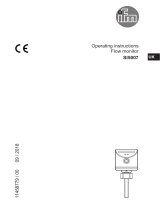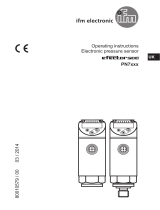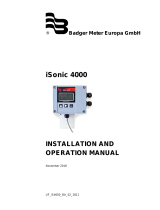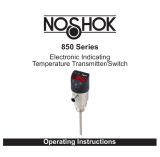
Operating instructions
Ultrasonic flow rate sensor
SU7001
SU8001
SU9001
80220979 / 00 11 / 2014
UK

2
Contents
1 Preliminary note ���������������������������������������������������������������������������������������������������4
1�1 Symbols used ������������������������������������������������������������������������������������������������4
1�1 Warning signs used ���������������������������������������������������������������������������������������4
2 Safety instructions �����������������������������������������������������������������������������������������������4
3 Functions and features ����������������������������������������������������������������������������������������5
4 Function ���������������������������������������������������������������������������������������������������������������6
4�1 Process measured signals ����������������������������������������������������������������������������6
4�2 Volumetric flow monitoring �����������������������������������������������������������������������������6
4�3 Consumed quantity monitoring (totaliser function) ����������������������������������������6
4�3�1 Consumed quantity monitoring with pulse output ���������������������������������7
4�3�2 Consumed quantity monitoring with preset counter �����������������������������7
4�4 Temperature monitoring ���������������������������������������������������������������������������������7
4�5 Volumetric flow or temperature monitoring / switching function ���������������������8
4�5�1 Hysteresis function �������������������������������������������������������������������������������8
4�5�2 Window function �����������������������������������������������������������������������������������8
4�6 Volumetric flow or temperature monitoring / analogue function ���������������������9
4�6�1 Voltage output 0 ��� 10 V (example volumetric flow monitoring) ������������9
4�6�2 Current output 4 ��� 20 mA (example volumetric flow monitoring) �������10
4�7 Start-up delay ����������������������������������������������������������������������������������������������10
4�8 Customer-specific calibration (CGA) �����������������������������������������������������������13
5 Installation����������������������������������������������������������������������������������������������������������14
5�1 Recommended mounting position ���������������������������������������������������������������14
5�2 Non recommended installation position �������������������������������������������������������15
5�3 Installation in pipes ��������������������������������������������������������������������������������������16
6 Electrical connection ������������������������������������������������������������������������������������������16
7 Operating and display elements ������������������������������������������������������������������������18
8 Menu ������������������������������������������������������������������������������������������������������������������19
8�1 Menu structure ���������������������������������������������������������������������������������������������19
8�2 Explanation of the menu ������������������������������������������������������������������������������20
9 Set-up ����������������������������������������������������������������������������������������������������������������21
10 Parameter setting ��������������������������������������������������������������������������������������������21
10�1 Parameter setting in general ���������������������������������������������������������������������22

3
UK
10�1�1 Change from menu level 1 to menu level 2 ��������������������������������������22
10�1�2 Locking / unlocking ���������������������������������������������������������������������������23
10�1�3 Timeout ��������������������������������������������������������������������������������������������� 23
10�2 Settings for consumed quantity monitoring �����������������������������������������������23
10�2�1 Configure limit value monitoring with OUT1 �������������������������������������23
10�2�2 Configure limit value monitoring with OUT2 �������������������������������������24
10�2�3 Configure analogue value for volumetric flow �����������������������������������24
10�3 Settings for consumed quantity monitoring �����������������������������������������������24
10�3�1 Configure quantity monitoring via pulse output ��������������������������������24
10�3�2 Configure quantity monitoring via the preset counter �����������������������24
10�3�3 Setting the pulse value ���������������������������������������������������������������������25
10�3�4 Manual counter reset ������������������������������������������������������������������������ 25
10�3�5 Time-controlled counter-reset ����������������������������������������������������������� 26
10�3�6 Deactivate meter reset ���������������������������������������������������������������������26
10�3�7 Configure meter reset using an external signal ��������������������������������26
10�4 Settings for temperature monitoring ����������������������������������������������������������26
10�4�1 Configure limit value monitoring with OUT2 �������������������������������������26
10�4�2 Configure analogue value for temperature ���������������������������������������26
10�5 User settings (optional) ������������������������������������������������������������������������������27
10�5�1 Set standard unit of measurement for volumetric flow ���������������������27
10�5�2 Configuration of the standard display �����������������������������������������������27
10�5�3 Setting the output logic ���������������������������������������������������������������������27
10�5�4 Calibrate curve of measured values �������������������������������������������������27
10�5�5 Reset calibration data ����������������������������������������������������������������������� 27
10�5�6 Setting the start-up delay ������������������������������������������������������������������27
10�5�7 Set measured value damping �����������������������������������������������������������28
10�5�8 Set output status in fault condition ����������������������������������������������������28
10�5�9 Select the medium to be monitored ��������������������������������������������������28
10�6 Service functions ���������������������������������������������������������������������������������������28
10�6�1 Read min/max values for volumetric flow �����������������������������������������28
10�6�2 Reset all parameters to factory setting ���������������������������������������������28
11 Operation ���������������������������������������������������������������������������������������������������������29
11�1 Reading the process value ������������������������������������������������������������������������29
11�2 Change display unit in the Run mode ��������������������������������������������������������29
11�3 Read set parameters ���������������������������������������������������������������������������������30
11�4 Fault indications �����������������������������������������������������������������������������������������30

4
1 Preliminary note
1.1 Symbols used
►Instructions
> Reaction, result
[…] Designation of keys, buttons or indications
→Cross-reference
Important note
Non-compliance can result in malfunction or interference�
1.1 Warning signs used
CAUTION
Warning of personal injury�
Slight reversible injuries may result�
2 Safety instructions
• Please read this document prior to set-up of the unit� Ensure that the product is
suitable for your application without any restrictions�
• If the operating instructions or the technical data are not adhered to, personal
injury and/or damage to property can occur�
• Improper or non-intended use may lead to malfunctions of the unit or to unwan-
ted effects in your application� That is why installation, electrical connection,
set-up, operation and maintenance of the unit must only be carried out by
qualified personnel authorised by the machine operator�
• In order to guarantee the correct condition of the device for the operating time it
is necessary to use the device only for media to which the wetted materials are
sufficiently resistant (→ Technical data).
• The responsibility whether the measurement devices are suitable for the
respective application lies with the operator� The manufacturer assumes no
12 Technical data �������������������������������������������������������������������������������������������������� 30
13 Factory setting �������������������������������������������������������������������������������������������������31

5
UK
liability for consequences of misuse by the operator� Improper installation and
use of the devices results in a loss of the warranty claims�
• For medium temperatures above 50 °C (122 °F) some parts of the housing can
heat up to over 65 °C (149 °F)� Moreover, during installation or in case of a fault
(e�g� housing damage) media under high pressure or hot media can leak from
the system� To avoid personal injury, take the following measures:
►Install the unit according to the applicable rules and regulations�
►Ensure that the system is free of pressure during installation�
►Protect the housing against contact with flammable substances and
unintentional contact� To do so, equip the unit with suitable protection (e�g�
protective cover)�
►Do not press the pushbuttons manually; instead use another object (e�g�
ballpoint pen)�
3 Functions and features
Pressure Equipment Directive (PED): The units comply with section 3, article 3 of
the Directive 97/23/EC and must be designed and manufactured for non-super-
heated liquids of group 2 fluids in accordance with the sound engineering practice�
The unit monitors liquid media�
It detects the 3 process categories volumetric flow, consumed quantity, medium
temperature�
Application area
• Water
• Glycol solutions
• Low viscosity oils (viscosity: 7���40 mm²/s at 40 °C / 7���40 cSt at 104 °F)
• High viscosity oils (viscosity: 30���68 mm²/s at 40 °C / 30���68 cSt at 104 °F)
Selection of the medium to be monitored → 10.5.9�

6
4 Function
4.1 Process measured signals
The unit displays the current process values�
It generates 2 output signals according to the parameter setting�
OUT1: 3 selection options Parameter setting
- Switching signal for volumetric flow quantity limit value (→ 10.2.1)
- or pulse signal for quantity meter (→ 10.3.1)
- or switching signal for preset counter (→ 10.3.2)
OUT2: 4 selection options Parameter setting
- Switching signal for volumetric flow quantity limit value (→ 10.2.2)
- or switching signal for temperature limit value (→ 10.4.1)
- or analogue signal for volumetric flow quantity (→ 10.2.3)
- or analogue signal for temperature (→ 10.4.2)
- or input for external reset signal (InD) (→ 10.3.7)
If not used as an output, OUT2 (pin 2) can instead be used
as an input for an external reset signal
(→ 10.3.7)
4.2 Volumetric flow monitoring
The volumetric flow is monitored by an ultrasonic measuring system, the
measured signals are evaluated by the electronics�
The signals for measuring the volumetric flow quantity can be provided as follows:
1� Two switching signals for volumetric flow quantity limit values on output 1 and
output 2 (→ 4.5).
2� An analogue signal proportional to the volumetric flow (4���20 mA or 0���10 V)
on output 2 (→ 4.6)�
4.3 Consumed quantity monitoring (totaliser function)
The unit has an internal quantity meter which continuously totals the volumetric
flow quantity� The sum corresponds to the current consumed quantity since the
last reset�
• The current meter reading can be displayed�
• In addition the value before the last reset is saved� This value can also be
displayed�

7
UK
The meter saves the totalled consumed quantity every 10 minutes� After
a power failure this value is available as the current meter reading� If a
time-controlled reset is set, the elapsed time of the set reset interval is
also saved� So the possible data loss can be maximum 10 minutes�
The meter can be reset as follows:
→ 10.3.4 Manual counter reset�
→ 10.3.5 Time-controlled counter-reset�
→ 10.3.7 Configure meter reset using an external signal�
4.3.1 Consumed quantity monitoring with pulse output
Output 1 indicates a counting pulse when the set volumetric flow quantity has
been reached (→ 10.3.1)�
4.3.2 Consumed quantity monitoring with preset counter
Output 1 switches when the set volumetric flow quantity has been reached (→
10�3�2)� 2 types of monitoring are possible:
1� Time-dependent quantity monitoring (→ 10.3.5 Time-controlled counter-reset):
- If the quantity x is reached during t, output 1 switches and remains switched
until the counter is reset�
- If the quantity x is not reached after the time t has elapsed, the meter is auto-
matically reset and counting starts again; output 1 does not switch�
2� Non time-dependent quantity monitoring (→ 10.3.6 Deactivate meter reset)
- If the quantity x is reached, output 1 switches and remains switched until the
counter is reset�
4.4 Temperature monitoring
The following signals are provided for temperature monitoring:
1� A switching signal for temperature limit values on output 2 (→ 4.5)�
2� An analogue signal proportional to the temperature (4���20 mA or 0���10 V) on
output 2 (→ 4.6)�

8
4.5 Volumetric flow or temperature monitoring / switching
function
OUTx changes its switching status if it is above or below the set switching limits
(SPx, rPx)� The following switching functions can be selected:
4.5.1 Hysteresis function
Normally open: [OUx] = [Hno]
Normally closed: [OUx] = [Hnc]
First the set point (SPx) is set, then the
reset point (rPx) with the requested
difference�
When SPx is adjusted, rPx is
changed automatically; the diffe-
rence remains constant�
Example of volumetric flow monitoring
HY = hysteresis
4.5.2 Window function
Normally open: [OUx] = [Fno]
Normally closed: [OUx] = [Fnc]
The width of the window can be set by
means of the difference between SPx
and rPx�
SPx = upper value
rPx = lower value
Example of volumetric flow monitoring
FE = window
When set to the window function the set and reset points have a fixed hy-
steresis of 0�25 % of the final value of the measuring range� This keeps the
switching status of the output stable if the volumetric flow varies slightly�

9
UK
4.6 Volumetric flow or temperature monitoring / analogue
function
4.6.1 Voltage output 0 ... 10 V (example volumetric flow monitoring)
Factory setting Measuring range scaled
U [V]
10
0
0 MEW Q
U [V]
10
0
0 MEWAEPASP Q
MEW = final value of the measuring range
ASP = analogue start point: determines at which measured value the output signal is 4 mA
AEP =
analogue end point: determines at which measured value the output signal is 20 mA�
Minimum distance between ASP and AEP = 20 % of the measuring range�
In the set measuring range the output signal is between 0 and 10V�
For an output signal > 10 V the flow quantity is above the final value of the measu-
ring range�

10
4.6.2 Current output 4 ... 20 mA (example volumetric flow monitoring)
Factory setting Measuring range scaled
I [mA]
20
4
0 MEW Q
I [mA]
20
4
0 MEWAEPASP Q
MEW = final value of the measuring range
ASP = analogue start point: determines at which measured value the output signal is 4 mA
AEP =
analogue end point: determines at which measured value the output signal is 20 mA�
Minimum distance between ASP and AEP = 20 % of the measuring range�
In the set measuring range the output signal is between 4 and 20 mA�
For an output signal > 20 mA the flow quantity is above the final value of the
measuring range�
4.7 Start-up delay
The start-up delay dST influences the switching outputs of the volumetric
flow monitoring�
If the start-up delay is active (dST > 0), note: as soon as the volumetric flow
exceeds 0�5 % of the final value of the measuring range, the following processes
are carried out:
> The start-up delay is activated�
> The outputs switch as programmed:
ON for NO function, OFF for NC function�

11
UK
After the start of the start-up delay there are 3 options:
1� The volumetric flow increases quickly and reaches the set point / good range
within dST�
> Outputs remain active�
2� The volumetric flow increases slowly and does not reach the set point /good
range within dST�
> Outputs are reset�
3� Volumetric flow quantity falls below 0�5 % of the final value of the measuring
range within [dST]�
> Outputs are reset at once; dST is stopped�
Example: dST for hysteresis function
Condition Reaction
1Volumetric flow quantity Q reaches 0�5 %
of VMR
dST starts, output becomes active
2 dST elapsed, Q reached SP output remains active
3 Q below SP but above rP output remains active
4 Q below rP output is reset
5 Q reaches again 0�5 % of VMR dST starts, output becomes active
6 dST elapsed, Q has not reached SP output is reset
7 Q reaches SP output becomes active

12
Example: dST for window function
Condition Reaction
1 Volumetric flow quantity Q reaches 0�5 %
of VMR
dST starts, output becomes active
2 dST elapsed, Q reached good range output remains active
3 Q above SP (leaves good range) output is reset
4 Q again below SP output becomes active again
5 Q below rP (leaves good range) output is reset again
6 Q reaches again 0�5 % of VMR dST starts, output becomes active
7 dST elapsed, Q has not reached good
range
output is reset
8 Q reaches good range output becomes active

13
UK
4.8 Customer-specific calibration (CGA)
The customer-specific calibration allows changing the gradient of the curve of
measured values (→ 10.5.4)� It influences the display and the outputs�
140 % ME
W
100 % ME
W
60 % MEW
MEWQ
AV1
V0
V2
A = operating value for display and
output signals
Q = flow
MEW = final value of the measuring range
V0 = curve of measured values with
factory setting
V1, V2 = curve of measured values after
calibration
The change in the gradient is indicated in per cent� Factory setting = 100 %� After
a change the calibration can be reset to factory setting (→ 10.5.5)�

14
5 Installation
►Avoid deposits, accumulated gas and air in the pipe system�
5.1 Recommended mounting position
►Install the unit in that section of the plant where the medium flows under pres-
sure� This avoids disturbance by air bubbles�
►Install the unit so that the measuring pipe is completely filled�
►Arrange for inlet and outlet pipe lengths� Disturbances caused by bends, val-
ves, reductions, etc� are compensated for�
It applies in particular: No shut-off and control devices are allowed directly in
front of the unit�
S
a x D
F
S
b x D
F
S = disturbance
D = pipe diameter
F = flow direction
SU7001, SU8001: a = 5 b = 2
SU9001: a = 8 b = 3
►Install in front of or in a rising pipe�
F
F

15
UK
5.2 Non recommended installation position
►Avoid the following installation positions:
FF
Directly in front of a falling pipe� In a falling pipe�
F
F
At the highest point of the pipe
system�
Directly in front of the spout of the
pipe�
FF
On the suction side of a pump� Flow rate direction horizontal, unit
vertical, connector upwards�
F = flow direction

16
5.3 Installation in pipes
The unit can be installed in pipes using adapters�
Information about the available adapters at www�ifm� com�
D C B ADCBA
1� Screw the adapter (B) into the pipe (A)�
2� Place the seals (C) and install the unit according to the marked flow direction�
►To mount the adapters on the process connection of the sensor use
suitable lubricants�
3� Screw the adapter (B) with the threads (D) until it is hand-tight�
4� Tighten the two adapters in opposite direction (tightening torque: 30 Nm)�
After installation air bubbles in the system can affect the measurement�
Corrective measures:
►Rinse the system after installation for ventilation�
- Rinsing quantity for SU7001 / SU8001: > 1 gpm; > 4 l/min
- Rinsing quantity for SU9001: > 5 gpm; > 20 l/min
6 Electrical connection
The unit must be connected by a qualified electrician�
The national and international regulations for the installation of electrical
equipment must be adhered to�
Voltage supply according to EN 50178, SELV, PELV�
►Disconnect power�
►Connect the unit as follows:

17
UK
43
2 1
BK: black
BN: brown
BU: blue
WH: white
BN
WH
BK
BU
4
1
3
2OUT2
L+
L
OUT1
Colours to DIN EN 60947-5-2
Sample circuits:
2 x positive switching 2 x negative switching
L
L+
3 BU
4 BK
2 WH
1 BN
L
L+
3 BU
4 BK
2 WH
1 BN
1 x positive switching / 1 x analogue 1 x negative switching / 1 x analogue
L+
L
3 BU
4 BK
2 WH
1 BN
L+
L
3 BU
4 BK
2 WH
1 BN
Pin 1 L+
Pin 3 L-
Pin 4
(OUT1)
• Switching signal: limit values for volumetric flow
• Switching signal: quantity meter reached preset value
• Pulse signal: 1 pulse every time the defined volumetric flow quantity is
reached
Pin 2
(OUT2/InD)
• Switching signal: limit values for volumetric flow
• Switching signal: limit values for temperature
• Analogue signal for volumetric flow
• Analogue signal for temperature
• Input for external reset signal (InD)

18
7 Operating and display elements
SetMode/
Enter
1 to 8: Indicator LEDs
• LEDs 1-5 = unit of the currently represented numerical value → 11.1 Reading the
process value
• LED 6 = not used
• LED 7 = switching status of output OUT2 / of input InD
• LED 8 = switching status of output OUT1
9: Alphanumeric display, 4 digits
• Current volumetric flow quantity (with setting [SELd] = FLOW)
• Meter reading of the totaliser (with setting SELd = TOTL)
• Current medium temperature (with setting SELd = TEMP)
• Parameters and parameter values
10: [Mode/Enter] button
• Selecting the parameters
• Reading the set values
• Confirming the parameter values
11: [Set] button
• Selection of the parameters
• Activation of the setting functions
• Changing the parameter values
• Change of the display unit in the normal operating mode (Run mode)

19
UK
8 Menu
8.1 Menu structure
Mode/Enter
Set
gal = current meter count in gal
gal* = stored meter count in gal

20
8.2 Explanation of the menu
SP1 / rP1 Upper / lower limit value for volumetric flow
ImPS Pulse value
ImPR Pulse repetition active (= pulse output function) or not active
(= preset counter function)
OU1
Output function for OUT1 (volumetric flow or consumed quantity):
- Switching signal for the limit values: hysteresis function or window func-
tion, either normally open or normally closed
- Pulse or switching signal for quantity meter
OU2
Output function for OUT2 (volumetric flow or temperature):
- Switching signal for the limit values: hysteresis function or window func-
tion, either normally open or normally closed
- Analogue signal: 4���20 mA [I] or 0���10 V [U]
As an alternative: configure OUT2 (pin 2) as input for external reset signal:
Setting: [OU2] = [InD]
SP2 / rP2 Upper / lower limit value for volumetric flow or temperature
ASP Analogue start value for volumetric flow or temperature
AEP Analogue end value for volumetric flow or temperature
DIn2 Configuration of the input (pin 2) for counter reset
EF Extended functions / opening of menu level 2
HI / LO Maximum / minimum value memory for volumetric flow
CGA Customer-specific calibration of the curve of measured values
CAr Reset calibration data
FOU1 Status of output 1 in case of a device fault
FOU2 Status of output 2 in case of a device fault
dST Start-up delay
P-n Output logic: pnp / npn
dAP Measured value damping / damping constant in seconds
rTo Meter reset: manual reset / time-controlled reset
diS Update rate and orientation of the display
Uni Standard unit of measurement for volumetric flow: gal/minute or gal/hour
SELd Standard measured variable of the display: volumetric flow value / meter
reading / medium temperature
SEL2
Standard measured variable for evaluation by OUT2:
- limit value signal or analogue signal for volumetric flow
- limit value signal or analogue signal for temperature
MEDI Selection of the medium to be monitored
rES Restore the factory setting
Page is loading ...
Page is loading ...
Page is loading ...
Page is loading ...
Page is loading ...
Page is loading ...
Page is loading ...
Page is loading ...
Page is loading ...
Page is loading ...
Page is loading ...
-
 1
1
-
 2
2
-
 3
3
-
 4
4
-
 5
5
-
 6
6
-
 7
7
-
 8
8
-
 9
9
-
 10
10
-
 11
11
-
 12
12
-
 13
13
-
 14
14
-
 15
15
-
 16
16
-
 17
17
-
 18
18
-
 19
19
-
 20
20
-
 21
21
-
 22
22
-
 23
23
-
 24
24
-
 25
25
-
 26
26
-
 27
27
-
 28
28
-
 29
29
-
 30
30
-
 31
31
IFM SU8001 Operating instructions
- Category
- Measuring, testing & control
- Type
- Operating instructions
Ask a question and I''ll find the answer in the document
Finding information in a document is now easier with AI
Related papers
-
IFM SU8000 Operating instructions
-
IFM SDG207 Operating instructions
-
 IFM Electronic SI5007 Operating instructions
IFM Electronic SI5007 Operating instructions
-
IFM SD6101 Operating instructions
-
IFM SD6101 Operating instructions
-
IFM PN028A Operating instructions
-
IFM SD6020 Operating instructions
-
IFM PN7303 Operating instructions
-
IFM SI5010 Operating instructions
-
IFM PK6533 Operating instructions
Other documents
-
 IFM Electronic PN7693 Operating Instructions Manual
IFM Electronic PN7693 Operating Instructions Manual
-
Atos GS470 Owner's manual
-
Schneider Electric XZCP1141L5. Operating instructions
-
Comac Cal FLOW 33 User manual
-
Rosemount 326P Pressure Transmitter Quick start guide
-
Comac Cal FLOW 38 User manual
-
 Comac Cal FLOW 32 User manual
Comac Cal FLOW 32 User manual
-
 Badger Meter iSonic 4000 Operating instructions
Badger Meter iSonic 4000 Operating instructions
-
 NOSHOK 850 Series Electronic Temperature Switch User manual
NOSHOK 850 Series Electronic Temperature Switch User manual
-
SMC Networks PF2W7 Series Operating instructions



































